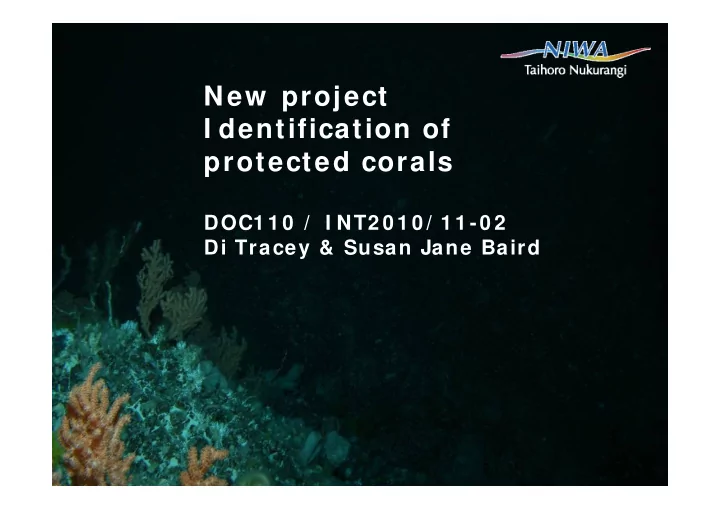

New project I dentification of protected corals DOC1 1 0 / I NT2 0 1 0 / 1 1 -0 2 Di Tracey & Susan Jane Baird
Overall Objective To analyse the spatial distribution of coral sub-samples returned through the CSP observer programme in relation to fishing effort (2007/ 08 – 2009/ 10) Specific Objectives: 1) To identify areas where deep sea corals are at highest risk of interactions with fishing gear 2) To assess the value of identifying sub- samples of corals returned by observers and, specifically, whether there is an ongoing need to monitor and quantify the level of interaction between fisheries and protected corals
Methods Obj 1 . I dentify areas identify target fisheries with coral bycatch Data sources COD data 2007 - 2010 • coral species catch weight • target fisheries • fishing area • geographic occurrence (e.g. latitude, longitude, depth) • catch effort data for the target fish species (orange roughy, oreos, etc). Spatial distribution Plot distribution of bycatch of each coral taxon, or group of corals in relation to the observed fishing effort. Groom ing grouping of certain codes to a higher level taxon (e.g., black coral, bamboo corals grouped)
Distribution plots of stony corals Note: numerous data sources, from Consalvey et al., 2006; from Tracey et al., in prep.
Exam ple output Observed coral bycatch overlaid on the deepsea trawl fishing effort in ½ degree squares on the Chatham Rise (from Tracey et al 2008)
Methods Obj 2 . Assess value of carrying out ID’s Data groom ing verify observed codes, level of taxon identified (family or genus) Data exclusion multiple taxa in a bag mismatch of number of corals (> or < samples found by expert taxonomist) Groom ing exercise m ay highlight need for further training or additional descriptors in the coral guide Quantitative analysis compare allocated MFish species codes (Observers) with NIWA expert allocated code (follow method of (Parker et al., 2009; Tracey et al., 2010) measure level of agreement & proportion of difficult-to-identify species
Exam ple of com parison Table 4: Comparison of NIWA versus scientific observer classification of VME bycatch in the 2009-10 Ross Sea longline fishery. For each specimen retained by an observer, the correct NIWA classification is provided. Shaded cells indicate agreement between observer and NIWA classifications. Columns describe how often the observer’s classification was correct. Rows describe how often samples from a given group were correctly identified. Observer Classification Bathylasmatidae Chemosynthetic Anthoathecatae Demospongiae Hexactinellida Pennatulacea nothing in log Adamussium Stylasteridae Brachiopoda Gorgonacea Antipatharia Grand Total Alcyonacea Holothurian Scleractinia unidentified Polychaeta Zoanthidea Ascidiacea Bryozoans Serpulidae not a code Cidaroida Actiniaria Euryalida colbecki Cnidaria Porifera omitted NIWA Classification Actiniaria 131 2 1 3 5 6 3 151 Adamussium colbecki 1 1 Alcyonacea 1 5 4 1 5 1 5 22 Anthoathecatae 2 3 3 1 9 Antipatharia 3 3 Ascidiacea 1 61 3 2 1 3 8 79 Bathylasmatidae 3 1 4 Brachiopoda 0 Bivalvia 1 1 Bryozoans 1 3 1 3 5 13 Chemosynthetic 0 Cidaroida 10 1 1 12 Demospongiae 1 17 60 16 3 3 4 104 Echinoidea 3 3 Euryalida 31 6 37 Gorgonacea 10 2 109 1 6 9 6 1 10 10 164 Hexactinellida 2 44 58 1 1 3 6 115 Holothurian 1 1 5 7 Ophiuroidea 9 9 Pennatulacea 42 4 46 Polychaeta 1 1 2 Scleractinia 2 127 2 3 1 135 Serpulidae 1 1 Stalked crinoid 5 5 Stylasteridae 2 7 71 70 5 6 161 Zoanthidea 6 3 1 7 2 1 20 Zoarcidae 1 1 Jellyfish 1 1 2 Unstalked crinoid 2 2 Grand Total 135 1 6 13 3 88 3 1 5 7 13 1 112 40 132 75 5 45 1 4 208 1 88 19 1 1 56 45 1109 Percent correct 0.97 1.00 0.83 0.38 1.00 0.69 1.00 0.00 0.60 0.00 0.77 0.00 0.54 0.78 0.83 0.77 0.20 0.93 1.00 0.00 0.61 1.00 0.80 0.37
S um m ary of key activities Request COD data extract Groom the data (observer catch effort & coral catch) Map the coral species (or coral groups where appropriate) against the observed fishing effort by target species Prepare Final Report for DOC which will show & discuss • coral distribution relative to fishing • provide an assessment of the value of at-sea sampling / sub- sampling of protected corals • help assess the ongoing need to monitor and quantify the level of interaction between fisheries and protected corals
Recommend
More recommend